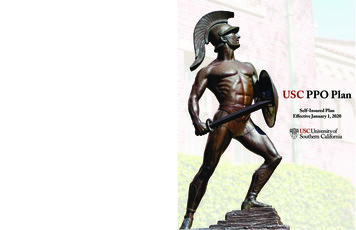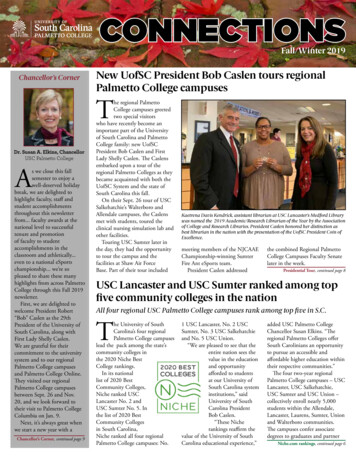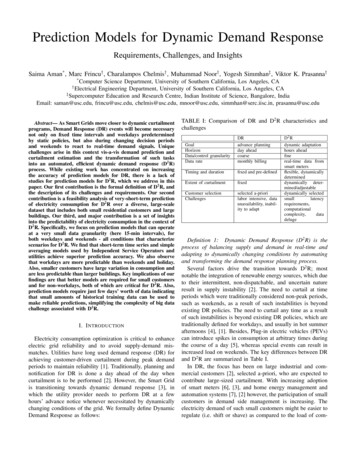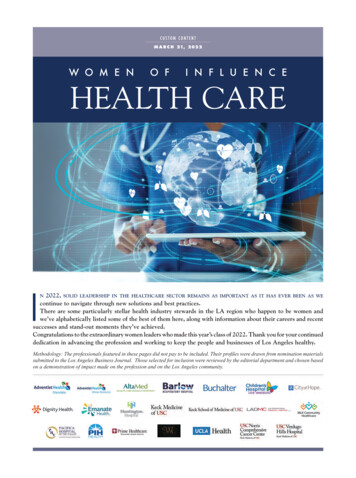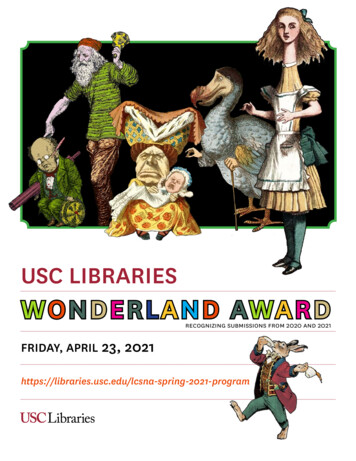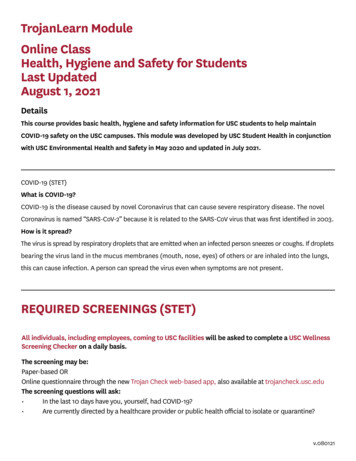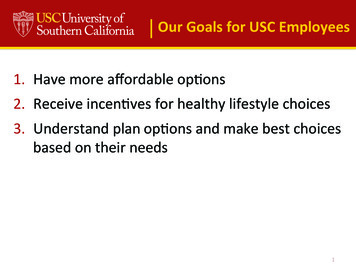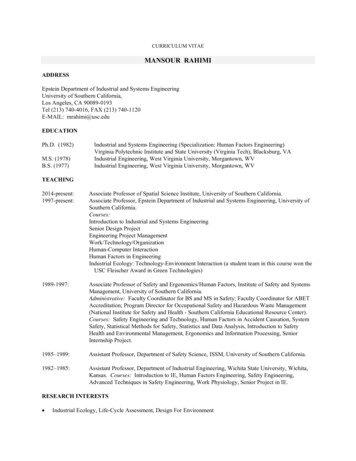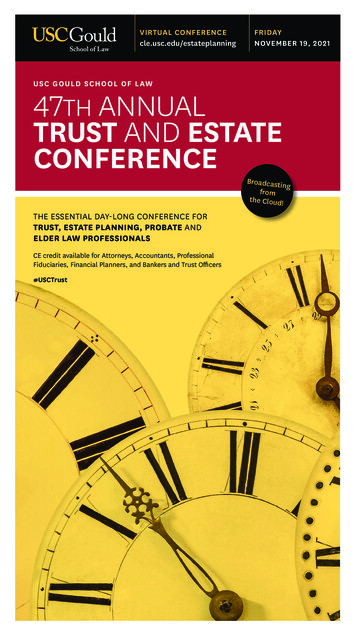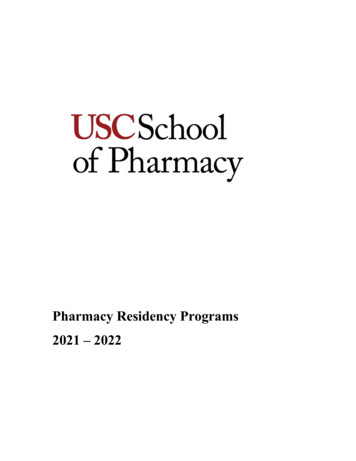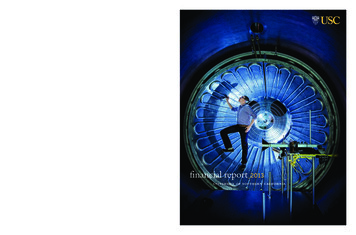
Transcription
9977 USC coverform final.r2 Layout 1 11/22/13 3:28 AM Page 1University ParkLos Angeles, CA 90089usc.edufinancial report 2013UNIVERSITY OF S O U T H E R N CALIFORNIAFor information andadditional copies of thisreport, please contact:University of Southern CaliforniaUniversity Park, UGB 205Los Angeles, CA 90089-8005(213) 821-1900about.usc.edu
9977 USC coverform final.r3 Layout 1 11/22/13 3:00 PM Page 2On the cover The CollaborativeHigh Altitude Flow Facility(CHAFF), a joint USC andAir Force facility housed on theUniversity Park Campus, is alarge vacuum chamber simulatingspace environments for a hostof applications — from testingpropulsion systems to materialsbehavior. (USC/Chris Shinn)Produced by the Officeof the University Comptrollerand published by UniversityCommunications, Office ofUniversity Publications, 2013Design: Rick Simner Design03 RESEARCH AT THE INTERSECTION09 UNIVERSITY HIGHLIGHTS14 ACADEMIC HIGHLIGHTS23 FINANCIAL STATEMENTS28 NOTES TO FINANCIAL STATEMENTS42 BUDGET 2013-201453 USC ROLE AND MISSIONUNIVERSITY LEADERSHIP, inside back coverPhotos by: Cover, Chris Shinn;inside front cover, Justin Ichida Lab,Lick Pui Lai/Andy McMahon Lab;p. 2 Kim Fox Photography; p. 4R&D Magazine, Justin Ichida Lab;p. 5 Philip Channing; p. 6 ElisabethRutledge/Andy McMahon Lab,Chris Shinn; p. 7 Qi-Long YingLab, Chris Shinn; p. 8 Chris Shinn,FJ Gaylor Photography; p. 9 BillHebert; p. 10 Chris Shinn; p. 12Gus Ruelas; p. 13 Philip Channing;p. 14,William Vasta; p.15 PhilipChanning, Gregory Creech,WilliamVasta; p. 16 Ed Carreon, Jim Haw,Alexander Iziliaev; p 17 PhilipChanning, Craig Schwartz, SteveCohen; p. 18 Meiki Takechi Arquillos, Philip Channing, Julie Glassberg;p. 19 Philip Channing, Chris Shinn,Lisa Brook; p. 20 Chris Shinn,TomQueally; p. 21 Brian Goodman,Philip Channing; p. 22 PhilipChanningPrinting: ColorGraphics
9977 USC upfront final.r1 USCFR 11/21/13 12:27 AM Page 1research at the intersection of science and the humanities
Holocaust survivors are interviewedon USC's three-dimensional videotapingstage for the USC Shoah Foundation'sNew Dimensions in Testimony Project.
University of Southern California2012 FINANCIAL REPORT /imagine being blind and having your visionpartially restored. Or watching an embryonicheart beat as it develops its chambers. Or havinga conversation with a 3D hologram of a Holocaustsurvivor — long after this person has passed away.This year, USC researchers worked across disciplinesto achieve these and other breakthroughs that arechanging the way we live now and in the future.3
4 / 2013 FINANCIAL REPORT University of Southern CaliforniaEli and Edythe Broad Center for Regenerative Medicine and Stem Cell Research at USCMotor neurons derived from a patient with ALSUSC Stem Cell, the Regenerative MedicineInitiative, promotes collaborative, multidisciplinary research across the university.PROVOST PROFESSOR MARK S. HUMAYUN and ateam of researchers developed the Argus II, the world’sfirst artificial retina approved for use in the United Statesand the European Economic Area. Produced by SecondSight Medical Products, the device is intended to restoresome vision to people suffering from blindness causedby the inherited disease retinitis pigmentosa.“In the patients who have received implants to date,the improvement in the quality of life has been invaluable,”said Humayun, who holds joint appointments as ProvostProfessor at the Keck School of Medicine of USC and theUSC Viterbi School of Engineering and is director of theUSC Eye Institute. “The fact that many patients can usethe Argus implant in their activities of daily living, such asrecognizing large letters, locating the position of objectsand more, has been beyond our wildest dreams.”Even wilder dreams are being realized as USCexpands its biomedical enterprise through a series oftransformative faculty hires.Provost Professor Andrew P. McMahon left HarvardUniversity to accept joint appointments at the Keck
University of Southern California2013 FINANCIAL REPORT /“USC Stem Cell allows us to tap into thecollective power of USC’s researchers in basicsciences, medicine, pharmacy, gerontology,dentistry, computing, engineering and beyond.”– Andrew P. McMahon, Provost ProfessorSchool and the USC Dornsife College of Letters, Artsand Sciences. He chairs the newly created Departmentof Stem Cell Biology and Regenerative Medicine andserves as director of the Eli and Edythe Broad Center forRegenerative Medicine and Stem Cell Research at USC.Shortly after his arrival, he spearheaded USC Stem Cell,the Regenerative Medicine Initiative, to promote collaborative, multidisciplinary research across the university.“USC Stem Cell allows us to tap into the collectivepower of USC’s researchers in basic sciences, medicine,pharmacy, gerontology, dentistry, computing, engineeringand beyond,” said McMahon, who studies the development,repair and regeneration of critical organ systems, includingthe kidney. “The goal is to translate our research fromthe laboratory to the bedside, helping patients who sufferfrom birth defects, injury and chronic disease.”Another bold visionary and recent USC recruit,Provost Professor Scott E. Fraser, is a world leader in imaging biological structures and molecular signals to betterunderstand complex events such as embryonic development and disease processes. Formerly a professor at theCalifornia Institute of Technology, he now serves as USC’sdirector of science initiatives and holds joint appointmentsat USC Viterbi and USC Dornsife.“What excites me most about my research,” he said,“is when we obtain findings that others have declared areimpossible to obtain.”USC continued to dial up its biomedical brainpowerwhen Provost Professor Arthur W.Toga and Professor PaulThompson, along with around 100 other faculty, researchersand multidisciplinary staff in their world-renowned Laboratory of Neuro Imaging, moved from UCLA to USC.Thesecelebrated experts will form the core of a new neuroinformatics institute, which will use powerful computers to seethe circuitry of the human brain and aid our understandingof Alzheimer’s, schizophrenia, depression and other diseases.The investigators hope to forge collaborations withcolleagues at the Eli and Edythe Broad Center for Regenerative Medicine and Stem Cell Research, the ZilkhaNeurogenetic Institute and other university partners.“We are both cases in point of the value of workingat the interface between disciplines,” Toga said. “We’re5
6 / 2013 FINANCIAL REPORT University of Southern California“We are both cases in point of thevalue of working at the interface betweendisciplines. We’re integrationists, verymuch trying to bring together a wholethat is greater than the sum of its parts.”– Arthur W. Toga, Provost Professor and Director of theUSC Institute for Neuroimaging and InformaticsAbove: Mouse embryo image from McMahon Labintegrationists, very much trying to bring together awhole that is greater than the sum of its parts.”USC’s School of Philosophy also has extended itsinterdisciplinary reach with the addition of a progressivefive-year BA/MA program in philosophy and law, and aninterdisciplinary major in philosophy, politics and law.The philosophy graduate program rose to number11 in the Philosophical Gourmet Report ranking, and the department hired three renowned professors from the University of Oxford: John Hawthorne, Ralph Wedgwoodand Gabriel Uzquiano Cruz.USC’s newest additions aren’t the only ones to garnerrecognition.In October, the Royal Swedish Academy of Sciencesawarded the Nobel Prize in chemistry for 2013 to Distinguished Professor Arieh Warshel and two colleagues fordeveloping the key principles behind computer simulationsthat are now indispensable in the study of chemical reactions.In the same month, fellow Nobel Laureate andDistinguished Professor George Olah and Professor G.K.Surya Prakash from the Chemistry Department received a 1 million prize from the State of Israel for their innova-tive research on alternative fuels. They also earnedrecognition from the nations of their birth: native Hungarian Olah received the 2013 Semmelweis Budapest Award,and Prakash was appointed to India’s National Academyof Sciences.Closer to home, President Barack Obama presenteda trio of Trojans with National Medals, the highest honorbestowed by the United States government for achievement in a variety of fields.Presidential Professor George Lucas accepted theNational Medal of Arts for transporting audiences to newworlds and creating some of the most beloved and iconicfilms of all time.Solomon W. Golomb, University Professor andDistinguished Professor of Electrical Engineering andMathematics, earned the National Medal of Science forhis work on “shift register sequences,” patterns of zerosand ones that have applications ranging from cellphonesystems to the Mars rovers’ deep-space communications.At the same ceremony, USC alumnus RangaswamySrinivasan, PhD ’56, of IBM was presented with theNational Medal of Technology and Innovation for his
University of Southern California2013 FINANCIAL REPORT /Neural stem cells derived from self-renewing embryonic stem cellscontributions to the development of LASIK eye surgery.Moving forward, USC continues to serve as a cruciblefor transformative technologies of the future.The USC Shoah Foundation, the USC Institute forCreative Technologies (ICT) and the exhibition designcompany Conscience Display are currently developingNew Dimensions in Testimony, which captures interviewswith Holocaust survivors. The resulting 3D holograms ofthe survivors will be able to tell their personal stories andengage in interactive conversations with future generations.The USC Shoah Foundation and ICT also joinedforces to create IWitness, a free multimedia educationalwebsite that allows teachers and students ages 13-18 toengage with more than 1,200 testimonies from survivorsand witnesses of the Holocaust and other genocides.So imagine the next research breakthrough —whether it’s a technological revolution, multimedia innovation or medical discovery. And then know that it’s justaround the corner thanks to the multidisciplinary, collaborative research that’s happening every day at USC.USC researchers work across disciplinesto achieve breakthroughs that are changingthe way we live now and in the future.7
47,358NUMBER OF APPLICANTSFOR FRESHMAN CLASSFALL 2013
University of Southern California2013 FINANCIAL REPORT /university highlights 12/13Demonstrating Dedicationto the Art of DanceUSC gained a sixth schooldedicated to the arts thanks tovisionary philanthropist anddance patron Glorya Kaufman,who hopes to enrich the lives ofgenerations of students as wellas the future of dance in LosAngeles and around the world.In fall 2012, Kaufman made atransformative gift to create theUSC Glorya Kaufman Schoolof Dance, the first school to beestablished through an endowment at USC in nearly 40 years.It joins USC’s five other artsschools — in architecture, cinematic arts, dramatic arts, fine artsand music — which collectivelycomprise one of the strongestuniversity arts offerings in theUnited States. Kaufman’s giftalso includes funds for the newschool’s instructional building,the Glorya Kaufman International Dance Center, scheduledfor groundbreaking in 2014.With Robert Cutietta as deanand internationally renowneddancer, choreographer and educator Jodie Gates as vice deanand director, the USC KaufmanSchool will open its doors in fall2015 to a select group of undergraduates who wish to earn abachelor’s degree in dance.Theschool will offer a dance minor,too, along with individual classesthat will be open to all students.“Joining the Glorya Kaufmanname to a new USC school ofdance greatly enhances USC’sunique signature as the nation’spremier research university witha deep commitment to the artsin all their manifestations,” saidElizabeth Garrett, USC provostand senior vice president foracademic affairs.The Degree Is in DisruptionWith a visionary gift frommusic industry leaders JimmyIovine and Andre Young (knownprofessionally as Dr. Dre), USCis launching an academy dedicated to empowering newgenerations of entrepreneurswho will disrupt the status quoby envisioning and implementing the creative services andsolutions of tomorrow.The USC Jimmy Iovine andAndre Young Academy for Arts,Technology and the Business ofInnovation will offer a four-yearcourse of study encompassingthree integrated areas of focus:visual and audio design, technology, and venture management.The fourth and final yearof study will bring students intoan experiential setting called the“Garage” where self-directed9
10 / 2013 FINANCIAL REPORT University of Southern Californiateams, which may includenon-academy students fromacross the university, will developtheir ideas into prototypes. Theseamless integration of artisticthinking, applied technology andimplementation strategies in theGarage experience signals USC’scommitment to groundbreakinginterdisciplinary education.Leading the program willbe top faculty from the USCRoski School of Fine Arts,Marshall School of Business,Viterbi School of Engineering,and Thornton School of Music,among others, with industryprofessionals, artists and innovators from a wide spectrum ofdisciplines serving as visitingfaculty, guest speakers andproject mentors.The academy will enroll itsfirst class — a select group of25 students who have demonstrated both academic excellence and a high capacity fororiginal thought — in fall 2014.Those who complete the academy program not only will beadept at integrating technologywith creative applications, butwill also have a thorough understanding of marketing anddistribution strategies.“The academy’s core education will create a common,multilingual literacy and fluencyacross essential disciplines,” saidUSC Roski Dean Erica Muhl,who will serve as the academy’sinaugural director. “This ‘bigpicture’ knowledge and skill willequip graduates with a leadership perspective that is unparalleled in an undergraduatedegree, and that will be applicable to virtually any industry.”Residential Colleges BlendLiving and LearningA valuable blend of living andlearning now defines the freshman experience at USC. As offall 2012, all USC freshmen arehoused in residential colleges,where they participate in anexciting community and benefitfrom the active involvementof resident faculty.“Hands down, research showsthat students who live on campus have higher GPAs and tendto be retained more if they’vebuilt a connection with faculty,”said Romando Nash, associatedean and executive director ofResidential Education.Case in point: Critical studiesmajor Burt Chaikin connectedwith Oliver Mayer, associateprofessor of dramatic arts andfaculty master at the International Residential College at
University of Southern California2013 FINANCIAL REPORT /As of fall 2012, all USC freshmen arehoused in residential colleges, where theyparticipate in an exciting communityand benefit from the active involvementof resident faculty.Parkside. After the two met ata faculty master dinner, Mayeragreed to serve as an adviser toChaikin, who hopes to start anew theatre troupe at USC.“Those things won’t happenunless you have connections withthe faculty,” said Chaikin. “It’sbeen another one of those USCopportunities — there are somany of them — and it’s up toyou whether or not you’re goingto take advantage of them.”The advantage of theresidential college concept issomething elite universities inGreat Britain and the UnitedStates have recognized for centuries: that learning takes placein dining halls as well as lecturehalls. USC’s first residentialcollege opened in 1987. Theuniversity now is home to 22resident faculty living in eightresidential colleges on theUniversity Park Campus.“That’s the essence of a university,” said Provost ElizabethGarrett. “Our goal is that all ourstudents take from their experience in the residential collegesan even greater appreciation forthe life of the mind and for thevalue of intellectual discourse.”Promoting Health and Valuein Health Care DeliveryMaking an impact is the hallmarkof the USC Leonard D. SchaefferCenter for Health Policy andEconomics. A unique collaboration between the USC PriceSchool of Public Policy and theUSC School of Pharmacy, thecenter was established in 2009with a generous gift fromLeonard and Pamela Schaeffer.In fall 2012, the Schaeffersendowed and supported the center with an additional gift. “Ournation faces grave health andfiscal challenges,” said Schaeffer,founding chairman and CEOof WellPoint, Inc., USC trusteeand holder of a Judge WidneyChair. “I support this center because its rigorous, independentand interdisciplinary researchprovides the foundation fordesigning effective policies toaddress these issues in both thepublic and private sectors.”In just a short time the centerhas produced results — novelanalyses of issues ranging fromwhich medical specialties aremost likely to face malpracticeclaims to the fiscal future ofSocial Security and Medicare— that are featured in leadingmedia outlets, such as The WallStreet Journal, The New York Timesand NPR, and published in toppeer-reviewed journals. Schaeffer Center faculty members alsodeliver their findings directly topolicymakers through congressional and legislative testimony.The center also has emergedas one of the country’s premierpolicy institutions.With a reputation for timely, relevant, evidence-based investigations, thecenter boasts more than 52million in external researchfunding, including grants fromthe National Institutes of Healthand the Centers for Medicareand Medicaid Services.Created in an era that demands new approaches to solving health care challenges, thecenter conducts the exactinginterdisciplinary research necessary to develop and evaluatesolutions for controlling healthcare costs and improving patientoutcomes in the United Statesas well as around the world.11
12 / 2013 FINANCIAL REPORT University of Southern CaliforniaUSC has taken on projects that willgenerate 12,000 jobs, create a centerfor community and university lifeand restore a Los Angeles landmark.Community members cheered city approval of USC Village.Investing in the CommunityCarrying forward its traditionof being an institution in thecity and of the city, USC hastaken on projects that will generate 12,000 jobs, create a centerfor community and universitylife, restore a historic Los Angeles landmark, and guarantee apermanent home for Trojanfootball.USC Village Hundreds ofcommunity members wearingcardinal and gold T-shirts gathered at City Hall to see theLos Angeles City Council voteunanimously in favor of USCVillage, an ambitious retailresidential project that is expected to return over a billiondollars in economic impact.On March 27, 2013, USCPresident C. L. Max Nikiasand then Los Angeles MayorAntonio Villaraigosa signed anagreement marking formalapproval of the redevelopmentproject. “Not only will USCVillage profoundly enrich ourUniversity Park Campus, it alsowill be a tremendous boon forour surrounding neighborhoods,and for all of Los Angeles,”Nikias said.More than 2 million squarefeet will be transformed into apedestrian-friendly mix ofrestaurants, retail stores, a grocerystore, student housing, academicbuildings and open space forconcerts, a farmers market andspecial events. USC Village willbe located on university-ownedland near Hoover and Jeffersonand is expected to create 8,000new permanent jobs and 4,000construction-related jobs.Los Angeles MemorialColiseum A unanimous voteon the final lease agreement bythe governing board of theCalifornia Science Centerhas ensured that Los AngelesMemorial Coliseum will be acontinuing treasure for thecommunity. In June 2013, theboard approved a 98-year leaseagreement that will allow USCto operate and restore the Coliseum and manage operation ofthe Los Angeles Sports Arenain Exposition Park.“USC is delighted that theBoard of Directors approvedthis agreement,” said Thomas S.Sayles, senior vice president ofUniversity Relations. “The dealis a win-win for the people ofLos Angeles, the museums inExposition Park, our community and USC.”USC has committed to making at least 70 million in renovations to restore the 90-year-oldhistoric landmark. The Trojanshave played at the Coliseumsince it opened in 1923.USC Extends ItsInternational ReachAlthough the bricks and mortarof the USC campuses resideproudly in Los Angeles, USCis truly a global institution —educating students to succeed inan increasingly interconnectedworld, funding fellowships forstudents from around the globe,opening a new internationaloffice in Brazil and hostingconferences abroad.In fall 2013, the USC Marshall School of Business welcomed students to its WorldBachelor in Business (WBB)degree, the first undergraduateprogram of its kind. Studentswill study not only at USC, butalso at The Hong Kong University of Science and Technologyand Università Bocconi inMilan — receiving business degrees from all three. As freshmanRobin Dey said, “The WBBprogram was exactly what I had
University of Southern CaliforniaLos Angeles Memorial Coliseumbeen looking for: independent,exploratory, challenging, just alittle risky and innovative.”While USC students headedabroad, the inaugural group ofUSC International Artist Fellows arrived in Los Angeles.This distinguished group includes a playwright from China,a guitarist from Russia, an animator from Brazil and a visualartist from Mexico. The program allows emerging artists tostudy with distinguished facultyfrom USC’s preeminent artsschools — Architecture, Cinematic Arts, Dramatic Arts, FineArts, Music and, soon, Dance.USC leaders traveled to SãoPaulo, Brazil, to open USC’seighth international office. Thisnew office will support recruitment of outstanding students,deliver student-learning programs in Brazil and promote research collaborations.USC hosted two major conferences abroad in 2012-13. Theinaugural USC Global Conversation in London brought together prominent economistsfrom both sides of the Atlanticto address the theme, “The Future of the Global Economy.”Speakers pointed to growth indeveloping countries and in aglobal knowledge economy asreasons for a rosier outlook.At the USC Global Conference in Seoul, South Korea,President C. L. Max Nikiashosted a three-day explorationof the university’s connectionsto Korea and the Asia Pacificregion. Keynote speaker andformer California GovernorArnold Schwarzenegger toldan audience of over 400 that“USC has big vision and thisconference is a perfect exampleof that.”6,000GRADUATE AND UNDERGRADUATESTUDENTS ENROLLED INUSC ART SCHOOLS2013 FINANCIAL REPORT /13
14 / 2013 FINANCIAL REPORT University of Southern Californiaacademic highlights 12/139,269INTERNATIONAL STUDENTSENROLLED AS OFFALL 2013
University of Southern CaliforniaUSC Leventhal Schoolof AccountingConsistently ranked amongthe nation’s top 10 accountingschools, the USC LeventhalSchool of Accounting retainedits coveted position in 2012-13.Under the leadership of DeanWilliam W. Holder, the schoolfinalized plans to roll out a newonline Master of Business Taxation (MBT) program, designedfor working professionals and offering course content accessibleto students at any time, at theirown pace, each week. One of thefirst academic institutions to recognize and act upon the need formajor change in accounting education, the school also created anintegrated program that both emphasizes fundamentals and equipsstudents with specialized skills.Its enhanced curricular offeringsprovide aspiring accountants withthe ethical and technical training— and hands-on experience —essential for success in a dynamicand increasingly complex field.From fostering a global perspective of accounting and taxationto raising the bar on professionaldevelopment and research techniques, USC Leventhal drewincreased attention to a studentbody poised to lead and a facultycommitted to excellence.USC School of ArchitectureThe USC School of Architecturesuccessfully recruited anotherdiverse class of undergraduate andgraduate students from aroundthe globe, with 33 countries nowrepresented among the studentbody. Faculty recruitment wasanother key initiative, with several world-class architects andeducators joining the alreadydistinguished faculty. The schoolalso added a graduate certificatein sustainable design and a dualMaster of Landscape Architecture/Master of Planning degree. Additionally, following its strong design-build tradition, the schoollaunched a multi-semester studioto foster design-builders. Called“M Studio,” the program isfunded by a gift from architectAnthony Marnell II ’72. BehindWatt Hall, students built an innovative, affordable, net-zero singlefamily home that’s a prototypefor modern urban design, andcompeted against 19 teams fromaround the world in the U.S.Department of Energy’s SolarDecathlon. The remodeling ofWatt Hall continues creating anexhibition and interactivehub to serve as the hearth ofthe school.Division of Biokinesiologyand Physical TherapyRanked as the number onephysical therapy program by U.S.News & World Report since 2004,the USC Division of Biokinesiology and Physical Therapy is acenter of excellence for education, clinical practice and research.The number and quality of applicants for the Doctor of PhysicalTherapy program, the biokinesiology program and the division’sfour residency programs are athistoric highs. USC PT Associates, the division’s faculty practiceon the University Park Campus,moved to new quarters at theEngemann Student Health Center, doubling the practice’s spaceand boosting its total revenueby 26 percent. Among many faculty distinctions, Kornelia Kuligdelivered the 18th John H.P.Maley Lecture at the 2013 American Physical Therapy Association’s national conference, andGeorge Salem presented hisstudy on yoga and its impact onseniors to the National Institutesof Health. In addition, the division held a kickoff celebrationto launch its fundraising initiative, part of the Campaign forthe University of SouthernCalifornia.2013 FINANCIAL REPORT /USC Marshall Schoolof BusinessWith a national reputation forpreparing tomorrow’s global business leaders, the USC MarshallSchool of Business continued toreshape the international businesslandscape in 2012-13. Guidedby Dean James G. Ellis, USCMarshall set a high standard forvisionary development and programmatic innovation. A majorcapital gift from Jill and FrankFertitta ’84 paved the way for atransformed educational environment at Marshall, funding construction of a new undergraduateinstructional building and establishing an endowed faculty chair.The school launched an arrayof new, leading-edge initiativesincluding the Master of Businessfor Veterans — a one-year, intensive degree program for veteranand active military personnel,translating skills acquired throughmilitary service to the businessenvironment. USC Marshall alsostrengthened its presence on theworld stage, connecting and creating opportunities for studentsand more than 80,000 Marshallalumni across 123 countriesand all 50 states.15
16 / 2013 FINANCIAL REPORT University of Southern CaliforniaUSC School ofCinematic ArtsDuring the past year, theUSC School of Cinematic Artsretained its ranking by The Hollywood Reporter as the number oneschool in the world for the studyof cinematic arts. The schoolannounced its seventh division,Media Arts Practice, whichrequires its majors to produceprojects that are equally substantive in scholarly and creative intent. The school also named theBryan Singer Division of CriticalStudies, the first division namedafter an alumnus. Students arenow taking classes in the Interactive Media Building, whichopened this summer, markingthe end of construction on thestate-of-the-art Cinematic ArtsComplex. In addition, FruitvaleStation, written and directedby recent alumnus RyanCoogler, with 14 Trojans in keycreative positions, was awardedboth the Audience Award andGrand Jury Prize at the SundanceFilm Festival and the Un CertainRegard Future Award at theCannes Film Festival.USC Dornsife College ofLetters, Arts and SciencesUnder the leadership of DeanSteve Kay, USC Dornsife continued to attract eminent additionsto its faculty with the recruitmentof a pioneering quantitative biologist, a leading labor and population economist, a renownedphilosopher in metaphysics andepistemology, and a team of topsocial psychologists. A number ofDornsife faculty were elected tothe American Academy of Artsand Sciences and the AmericanAssociation for the Advancementof Science in 2012-13. USCDornsife students were selectedfor prestigious Fulbright andMellon Mays Fellowships, as wellas Boren, McNair and GilmanScholarships. The new DornsifeNeuroscience Pavilion, whichhouses the Brain and CreativityInstitute, allows scientists andartists to image the human mindin action and explore the artswith performances in a worldclass auditorium.USC Annenberg Schoolfor Communicationand JournalismConstruction of cutting-edgeWallis Annenberg Hall remainson schedule. When the 2014-15academic year begins, the USCAnnenberg School for Communication and Journalism will be“two buildings strong,” with theschool’s original building also inuse. Faculty and students receivedprestigious honors, awards andrecognition. Dean Ernest J.WilsonIII was the W.E.B. Du BoisLecture Series speaker; ManuelCastells won the internationalBalzan Prize for Sociology; SarahBanet-Weiser won the International Communication AssociationOutstanding Book Award; HenryJenkins was named to the board ofthe George Foster Peabody Awards;and journalists from among USCAnnenberg’s six student-run mediaoutlets won awards competingagainst professionals. The GatesFoundation and the Knight Foundation provided a multimilliondollar research grant for measuring the social impact of media.USC Annenberg and the USCMarshall School of Businessestablished the Jayne and HansHufschmid Chair in StrategicPublic Relations and BusinessManagement.USC Kaufman Schoolof DanceThe U
about.usc.edu financial report _2013 UNIVERSITY OF SOUTHERNCALIFORNIA 9977_USC_coverform_final.r2_Layout 1 11/22/13 3:28 AM Page 1. . USC Viterbi School of Engineering and is director of the USC Eye Institute. "The fact that many patients can use the Argus implant in their activities of daily living, such as
